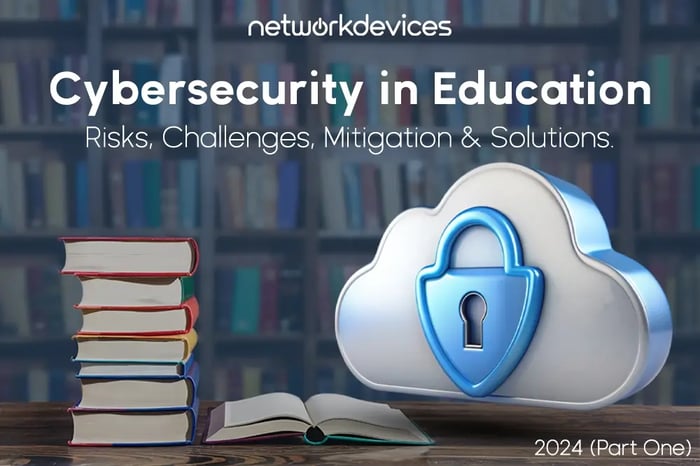You have no items in your shopping cart.

Top 5 Cyber Threats in Education for 2024
In 2024, the education sector—including schools, colleges, and universities—faces escalating cybersecurity threats that jeopardize sensitive data and disrupt operations.
The top 5 cyber threats in education in 2024 are as follows:
- Ransomware attacks
- Phishing Scams
- Insider Threats
- Credential Theft and Account Compromise
- Distributed Denial of Service (DDoS)
This comprehensive set of guidelines and best practices explicitly enhances the security posture of academic institutions.
Understanding the Major Cyber Threats Facing Education in 2024
- Storing large databases of sensitive information while maintaining minimal cybersecurity resources is a greater risk vector for educational institutions.
- Ransomware, Phishing, Insider Threats, and Credential Theft are the most significant cyber threats to educational institutions in 2024.
- ThreatDown Research report shows the number of attacks surged from 129 in 2022 to 265 in 2023.
- Lack of budget and little or no attention to the organization's cybersecurity posture are considered key elements in cyber attacks in educational institutions.
Ransomware: Crippling Schools & Universities
Ransomware remains a leading cyber threat in 2024, especially targeting schools, colleges, and universities. Cybercriminals exploit vulnerabilities in educational networks to encrypt critical data, such as student records and research information, demanding a ransom for decryption.
In 2023, Ransomware Attacks on the education sector reached unprecedented levels, with a staggering 70% increase in incidents compared to the previous year. ThreatDown research found that attacks on schools doubled from 129 in 2022 to 265 in 2023. This shows the importance of schools improving their cybersecurity defenses.
Phishing Scams in Education
Phishing continues to be a pervasive threat in the education sector. Cybercriminals trick people with fake emails to steal passwords or infect computers with harmful software.
These phishing scams often bypass basic security measures, leading to compromised accounts, unauthorized access to sensitive information, and potential data breaches.
Insider Threats
Insider threats, where individuals within an institution misuse their access, pose significant risks to cybersecurity in education. Whether intentional or accidental, these threats can lead to data theft, unauthorized sharing of sensitive information, or the sabotage of critical systems.
Schools, colleges, and universities must implement robust access controls and monitoring solutions to mitigate the risk of insider threats.
Credential Theft and Account Compromise in Educational Institutions
Credential theft is a growing concern for educational institutions. Hackers target online learning platforms, email systems, and other critical digital resources by stealing usernames and passwords.
Once they gain unauthorized access, they can exfiltrate sensitive data, launch further cyberattacks, or disrupt educational activities. The widespread use of shared accounts and weak password policies exacerbate this threat.
Distributed Denial of Service (DDoS)
DDoS attacks involve overwhelming a school's or university’s network infrastructure with excessive traffic, rendering online services and websites inaccessible. These attacks can disrupt online learning, exams, and access to educational resources, causing significant operational challenges.
As educational institutions increasingly rely on digital platforms, DDoS protection becomes critical to maintaining service availability.
Unified Cybersecurity Practices for Enhanced Threat Management in Education
Threat Hunting
Proactively searching for signs of malicious activity within the network helps identify threats before they cause significant damage. Organizations can find signs of attacks by looking for IoCs and TTPs. This allows them to catch threats that automated systems might not detect and respond to them.
Vulnerability Assessment/Management
Regularly identifying and evaluating vulnerabilities in systems and software helps prioritize and remediate weaknesses before they can be exploited. Effective vulnerability management ensures that patches and updates are applied promptly, reducing the risk of exploitation by attackers.
Incident Response
Having a well-defined incident response plan enables organizations to quickly and effectively address and mitigate the impact of a security breach.
This includes identifying the source of the attack, containing the incident, eradicating the threat, and recovering operations while minimizing data loss and system downtime.
Security Consolidation
Integrating and centralizing security tools and systems enhances visibility and control over the entire network. Consolidation reduces complexity, improves efficiency, and ensures that security measures work together seamlessly, providing better protection against sophisticated attacks.
Deep Visibility
Implementing solutions that offer comprehensive visibility into network traffic, user behavior, and system activities allows for early detection of anomalies and potential threats. Deep visibility helps understand the full scope of an attack, identify affected systems, and respond effectively to security incidents.
The Rising Threat Landscape in Educational Institutions
WMU (Western Michigan University) suffered a 13-day service disruption after a data breach. The IT infrastructure gradually became online, causing massive losses in educational services, the university’s reputation, and financial losses.
The rising threat landscape presents significant challenges for educational institutions. Schools, colleges, and universities are facing an increase in sophisticated cyberattacks—such as ransomware, phishing, and data breaches.
These institutions must enhance their cybersecurity measures. Proactive protection strategies are essential to safeguarding sensitive data and maintaining operational integrity in the digital age.
Escalating Threats: Why Education is a Prime Target
Hackers hijacked Bluefield University's emergency system to issue threats to students and faculty, adding the small private university in Virginia to the growing list of U.S. institutions targeted by ransomware. This incident highlights the increasing vulnerability of educational institutions to cyberattacks, underscoring the urgent need for robust cybersecurity measures.
Schools, colleges, and universities should prioritize cybersecurity in 2024 due to the escalating threat landscape. With rising incidents of ransomware attacks, phishing scams, and data breaches targeting educational institutions, robust cybersecurity measures are essential.
Prioritizing cybersecurity is crucial in protecting not only the physical and digital infrastructure but also the vast amounts of sensitive personal information stored within institutional databases. This includes student records, financial data, and research materials, all of which are highly attractive targets for cybercriminals.
Prioritizing Cybersecurity: A Necessity, Not a Choice
In 2024, educational institutions must treat cybersecurity as a top priority, not an option, to effectively combat and prevent data breaches and cyberattacks. The growing sophistication of cyber threats demands a proactive approach, with dedicated budgets allocated to cybersecurity initiatives.
Schools, colleges, and universities can significantly enhance their security posture by investing in threat and vulnerability management, regular security assessments, and robust incident response programs.
Conclusion: Safeguarding the Future of Education
Adopting comprehensive cybersecurity measures goes beyond just deploying technology solutions; it involves creating a culture of security awareness, continuous monitoring, and swift incident response.
As education becomes more digital, focusing on cybersecurity is crucial for keeping trust and ensuring the stability of essential institutions.






